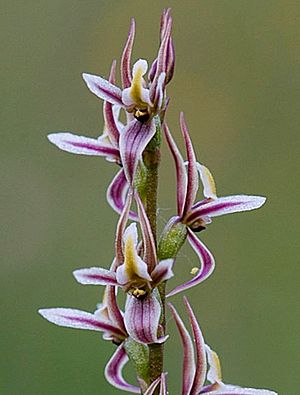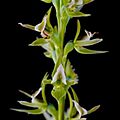Leek orchids facts for kids
Quick facts for kids Leek orchids |
|
|---|---|
 |
|
| P. petilum growing in the Australian Capital Territory | |
| Scientific classification |
|
| Kingdom: | Plantae |
| Clade: | Tracheophytes |
| Clade: | Angiosperms |
| Clade: | Monocots |
| Order: | Asparagales |
| Family: | Orchidaceae |
| Subfamily: | Orchidoideae |
| Tribe: | Diurideae |
| Subtribe: | Prasophyllinae |
| Genus: | Prasophyllum R.Br. (1810) |
| Type species | |
| Prasophyllum australe |
|
| Diversity | |
| About 140 species | |
| Synonyms | |
|
|
Prasophyllum, also known as leek orchids, is a group of about 140 different kinds of flowering plants. They belong to the orchid family, called Orchidaceae. You can find these unique plants growing in Australia and New Zealand.
In Australia, leek orchids grow in all states except the Northern Territory. They get their common name because their leaves are hollow and look a lot like a leek or an onion. Some types of leek orchids only bloom after summer bushfires. Their flowers often look similar to those of grass trees (Xanthorrhoea), which also flower at the same time. This suggests they might attract the same insects to help them spread their pollen.
Leek orchids are similar to another group of orchids called Genoplesium. However, leek orchids have a round, tube-like leaf, while Genoplesium orchids have flat leaves. Also, the special lip-like petal (called the labellum) on a leek orchid is firmly attached to the flower's central part (the column). Leek orchids come in many sizes, from the little laughing leek orchid (P. gracile), which is about 15 cm (6 inches) tall, to the king leek orchid (P. regium), which can grow up to 2 meters (6.5 feet) tall!
Contents
What Leek Orchids Look Like
Leek orchids are plants that grow in the ground. They are perennial, meaning they live for more than two years, and deciduous, which means their leaves fall off. They usually have a few thin roots and two round parts underground called tubers. These tubers help the plant store food. New tubers grow from short, root-like stems. Leek orchids mostly reproduce using their flowers, not by growing new tubers.
A single leaf grows near the bottom of the plant. This leaf is long, narrow, hollow, and shaped like a cylinder, just like a leek or onion. It's also smooth.
The Flowers of Leek Orchids
The flowers of leek orchids grow on a tall stem called an inflorescence. There can be a few or many flowers on this stem. The flowers break through a thin part of the leaf. Unlike many other orchids, their flowers do not turn upside down.
Each flower has three main parts that look like petals:
- The top petal (called the dorsal sepal) is wider than the two side petals.
- The two side petals (called lateral sepals) are often joined together.
- The true petals are usually curved and smaller than the sepals.
One special petal is called the labellum. This is the most unique part of the orchid flower. It sits above the central part of the flower (the column) and is firmly attached to its base. The edges of the labellum are often wavy and curled back. The labellum also has a raised, fleshy area called a callus, which is usually grooved.
The parts of the flower that help with reproduction are joined together into a short column. This column has narrow wings, sometimes with a small lobe at the front. Leek orchids typically bloom between late winter and early summer, depending on the specific type. After flowering, they produce a dry seed pod called a capsule, which can hold up to 500 tiny seeds.
Naming Leek Orchids
The group of plants called Prasophyllum was first officially described in 1810 by a botanist named Robert Brown. He published his description in a book called Prodromus Florae Novae Hollandiae. Brown described twelve different kinds of leek orchids. Later, in 1989, another botanist named Mark Clements chose P. australe as the main example species for the group.
The name Prasophyllum comes from two Ancient Greek words:
- Prason, which means "leek."
- Phyllon, which means "leaf."
So, the name perfectly describes their leek-like leaves!
Where Leek Orchids Grow
Leek orchids grow in all states of Australia, but they are not found in the Northern Territory. There are many different kinds of leek orchids in Australia. For example, Western Australia has 20 named species and about 40 more that have been found but not yet officially named. Tasmania has 28 species, New South Wales has about 40, and South Australia has 15.
New Zealand is also home to about 6 species of leek orchids. They grow on both the North and South Islands, as well as on Stewart Island and Chatham Islands. In Western Australia, you can find them in many different places, from the edges of salt lakes to swamps and even dense forests of Karri trees (Eucalyptus diversicolor).
How Leek Orchids Live and Grow
Leek orchids need special help to grow. They are mycotrophic, which means they rely on tiny fungi in the soil to help their seeds sprout. The main fungus they work with is called Ceratobasidium cornigerum. This is a type of symbiotic relationship, where both the orchid and the fungus benefit.
Many leek orchid species in Western Australia only flower after summer bushfires. In other years, they might only grow leaves. Most leek orchid flowers have a strong scent and produce a sweet liquid called nectar. Insects are usually attracted to these flowers and help them pollinate. However, a few types of leek orchids can pollinate themselves if no insects visit them.
As mentioned before, leek orchids often have flowers that look similar to grass trees (Xanthorrhoea). They also bloom under similar conditions and attract the same kinds of insects. This suggests that leek orchids might be mimicking grass tree flowers to attract pollinators.
Types of Leek Orchids
As of October 2017, there are about 140 recognized species of leek orchids. Eight new species were described in 2017, but they are not yet on the main list. These new species include P. crassum, P. nitidum, P. roseum, P. rousei, P. stygium, P. sylvicola, P. spadiceum and P. tortilis.
Species List
For a full list of all known leek orchid species, you can visit the List of Prasophyllum species page.
Images for kids
-
Prasophyllum elatum at the Strettle Road Reserve Glen Forrest in Western Australia
-
Prasophyllum sargentii growing near Hopetoun Western Australia
-
Prasophyllum brevilabre growing on Black Mountain in the Australian Capital Territory
-
Prasophyllum lindleyanum growing near Melbourne in Victoria
-
Prasophyllum sylvestre near the Tuross River in New South Wales
-
Prasophyllum montanum in the Namadgi National Park in the Australian Capital Territory








